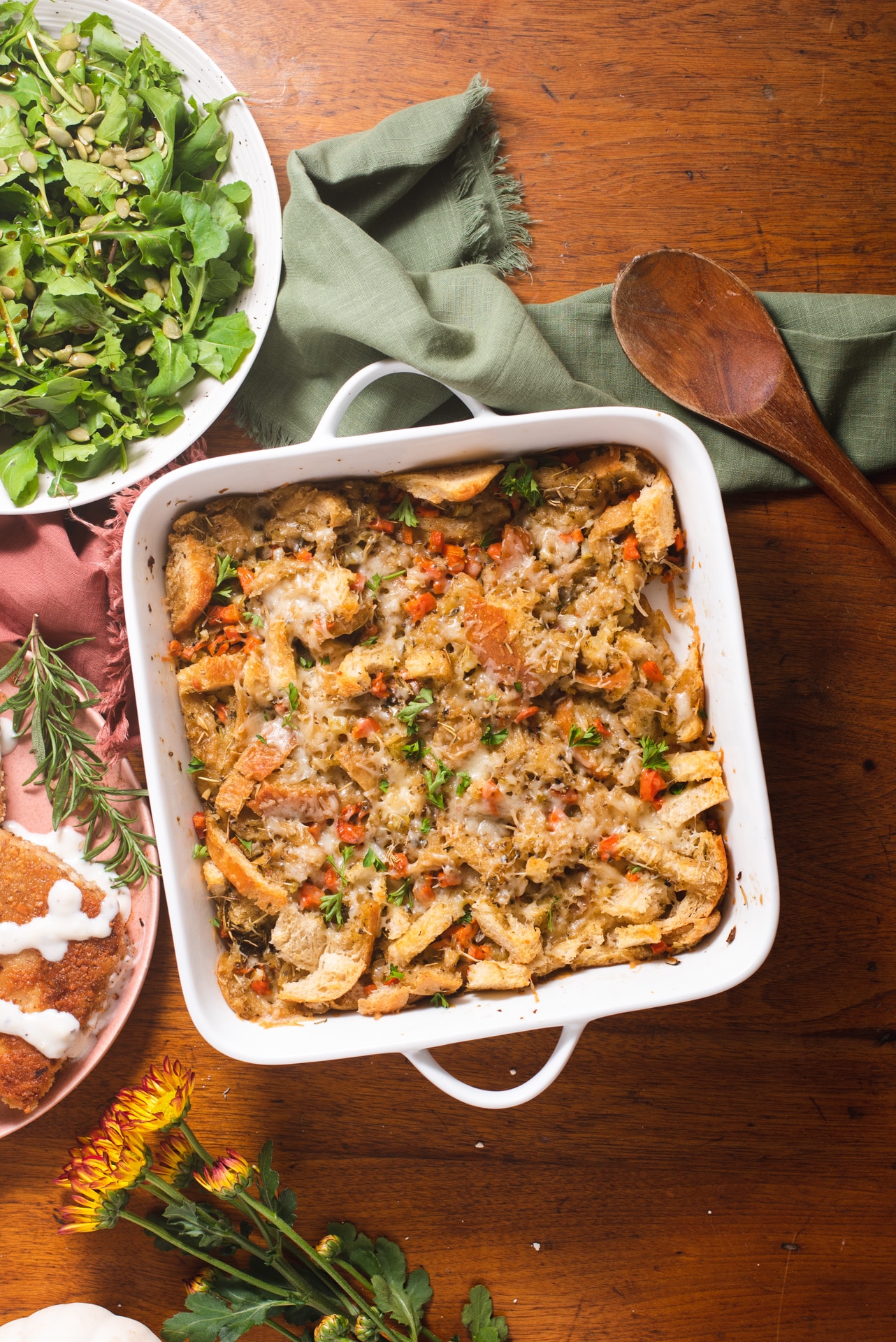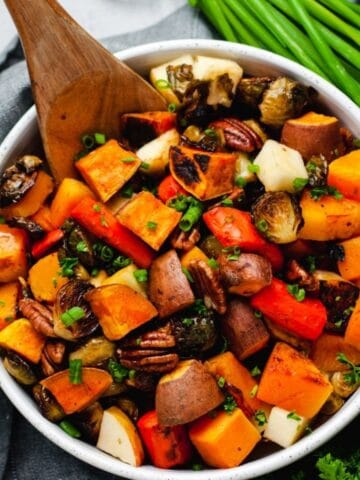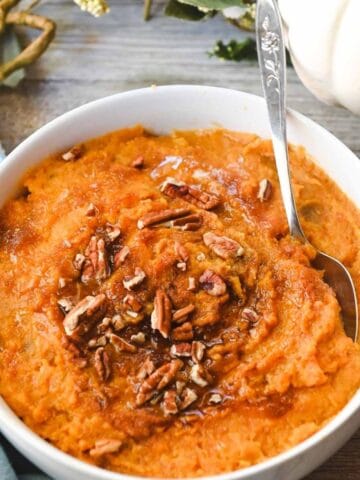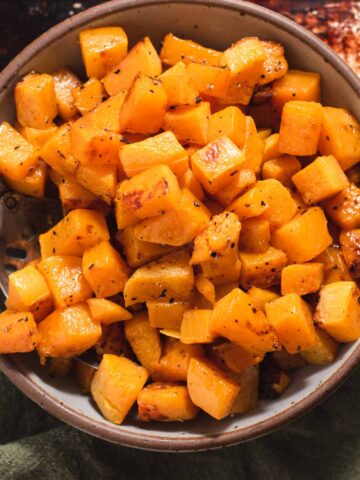Take homemade stuffing to the next level with this sourdough stuffing made with fresh herbs and Parmesan cheese! This simple yet decadent stuffing recipe is the perfect addition to your Thanksgiving table and requires just 20 minutes of active time.

While stuffing mix is good in a pinch, homemade sourdough stuffing is surprisingly quick and easy to make. It is my favorite way to add herby, savory flavor to Thanksgiving dinner.
Using sourdough bread in place of white or wheat bread adds a slightly chewy texture and extra flavor to an otherwise classic dish.
Add this stuffing to your table alongside vegan mushroom gravy and garlic cream cheese mashed potatoes and you're on your way to a delicious Thanksgiving meal!
Jump to:
Why this recipe works
- Quick & easy: Requires just 15 to 20 minutes of active cooking time.
- Herby flavor: Sourdough stuffing is filled with fresh herbs like rosemary, sage, and thyme. Don't have access to fresh herbs? This stuffing also works with dry herbs!
- Vegetarian-friendly: Stuffing is often made with chicken broth, but this one uses vegetarian broth to make it a vegetarian-friendly Thanksgiving or Christmas option.
- Versatile: This recipe works with all varieties of sourdough bread. It works with homemade sourdough, sourdough sandwich bread, and even whole wheat sourdough.
Ingredients

- Sourdough bread: Any variety of sourdough bread works, such as a traditional loaf or sourdough sandwich bread, but several day old/stale sourdough works best. See below for tips on how to dry out sourdough.
- Onion, carrot, celery, and garlic: Carrot is not traditionally used in stuffing but it adds a nice heartiness and pop of color to this dish. Sauté this "mirepoix" in olive oil to create a flavorful vegetable base.
- Vegetable broth: I recommend using a good, flavorful broth for this recipe since it contributes a lot to the stuffing flavor. Better than Bouillon vegetable base is my go-to way to make flavorful broth. Chicken broth does work for those who aren't vegetarian.
- Herbs: Parsley, sage, rosemary, and thyme (yes, just like the song!) add depth and robust flavor. I recommend using fresh herbs for maximum flavor but dry works too. One tablespoon of fresh chopped herbs can be replaced with one teaspoon dry.
- Parmesan: Shredded Parmesan adds a golden and cheesy crust to the stuffing.
- Salt & pepper for flavor. I recommend using freshly ground black pepper. Diamond Crystal kosher salt is my go-to salt.
- Melted butter: I recommend unsalted butter but salted also works, it will just result in slightly saltier stuffing.
Step-by-step instructions
Sourdough stuffing is made just like traditional stuffing.

- Sauté vegetables: In a large skillet over medium heat, sauté onion, carrot, and celery in olive oil with salt until softened. Add garlic and sauté until golden and aromatic.
- Add the fresh herbs: Cook for another minute to bloom the herbs, stirring frequently to avoid burning the herbs.
- Stir in the vegetable broth and pepper. Bring to a gentle simmer over medium-high heat.
- Place torn pieces of stale sourdough bread in a 7x11-inch or similarly sized baking dish (I'm using 10x10 in the photos). Drizzle with two tablespoons of melted butter. Pour in the simmering vegetable broth mixture, stirring to combine.
- Sprinkle Parmesan evenly over the stuffing. Cover with foil and bake for 30 minutes at 350F. Remove foil and bake another 10 minutes, until the cheese is golden and bubbling.
Expert tips and variations
- Different bread options: If you are just looking for a vegetarian stuffing recipe but don't necessarily want to use sourdough, you can use a more traditional option like white bread.
- Sliced vs torn bread cubes: Tearing sourdough yields more rustic-appearing stuffing. Cube the sourdough for a more classic, traditional result.
- Sausage: You can cook sausage alongside the vegetables for a sausage sourdough stuffing option. I usually use a meatless option like Beyond Sausage, but any kind works!
- Baking dish: Sourdough stuffing works in most styles of baking dishes. I usually use a 7x11-inch or similarly sized baking dish. In the photos, I use a 10x10-inch baking dish. Note that a wide baking dish yields crisper sourdough stuffing, while a deep baking dish creates stuffing that is mostly soft with a crisp top.
- Vegan option: Simply use an equal amount of dairy-free butter and vegan Parmesan in place of butter and Parmesan. I recommend Violife Parmesan block.
FAQ
Using stale bread keeps the stuffing from getting soggy. Bread becomes stale when it is exposed to air, so older bread is actually preferable to a fresh loaf of sourdough.
If you're short on time you can make stale bread with a fresh loaf of bread. Start by tearing the bread into bite-sized pieces. Evenly layer pieces of sourdough on a large sheet pan. Bake at 300F until almost toasted, about 15 to 20 minutes. The bread should still be slightly dried out but still a little soft.
As a rule of thumb, one slice of bread usually yields one cup of bread cubes. A standard loaf of sourdough bread yields about 10 cups of bread cubes.
Storage and make-ahead tips
To prep ahead: Most of the sourdough stuffing ingredients can be prepped in advance. Fresh bread can be torn into bite-sized pieces 2-3 days in advance. Prepare the sautéed vegetables and vegetable broth 1-2 days in advance. When you are ready to make the stuffing, simply pour melted butter and the warmed vegetable broth mixture over the stuffing and follow the recipe instructions to cook.
Leftovers: Stuffing is best enjoyed the same day, but you can keep leftovers refrigerated in a closed container for 3 to 4 days.

Looking for more Thanksgiving sides?
Check out my post on vegetarian Thanksgiving for even more ideas.
Did you try this recipe? You can leave a star rating in the recipe card or a review in the comments below. Or check out my new cookbook and keep up to date with my YouTube, Instagram, TikTok, or newsletter!
📖 Recipe
Want to Save This Recipe?
Enter your email & I'll send it to your inbox. Plus, get great new recipes from me every week!
By submitting this form, you consent to receive emails from Cozy Peach Kitchen

Herby Sourdough Stuffing
Ingredients
- 1 loaf stale sourdough bread see note #1
- 2 tablespoons extra virgin olive oil
- ½ cup finely chopped yellow onion about ½ small onion
- 2 stalks celery finely chopped
- 1 large carrot finely chopped
- ½ teaspoon kosher salt
- 3 cloves garlic minced
- 1 tablespoon each fresh chopped rosemary, parsley, thyme see note #2
- 2 teaspoons fresh chopped sage
- 1 ½ cups vegetable broth
- ¼ teaspoon freshly ground black pepper
- 3 tablespoons unsalted butter melted
- ½ cup shredded Parmesan
Instructions
- Tear the stale sourdough bread into 1-inch cubes. Aim for 9 to 10 cups of torn bread cubes. Set aside. See note #1 is your sourdough loaf is not stale.
- Preheat the oven to 350F. Lightly grease a 7x11 or similarly sized baking dish.
- Heat a large skillet over medium heat. Add olive oil. Once hot, add onion, carrot, celery, and salt. Sauté until softened, about 6 to 8 minutes. Add garlic and sauté an additional 2 to 3 minutes, or until golden and aromatic.
- Stir in the rosemary, parsley, thyme, and sage. Cook for another minute to bloom the herbs, stirring frequently.
- Stir in the vegetable broth and pepper. Bring to a gentle simmer over medium-high heat.
- Meanwhile, add stale bread to the baking dish. Drizzle with melted butter. Pour in the simmering vegetable broth mixture, stirring to combine. Sprinkle Parmesan evenly over the stuffing.
- Cover with foil and bake for 30 minutes at 350F. Remove the foil and bake another 10 to 15 minutes, until the cheese is golden and bubbling. Enjoy!
Notes
- Sourdough bread: To make stale bread with a fresh loaf, start by tearing bread into bite-sized pieces. Evenly layer pieces of sourdough on a large sheet pan. Bake at 300F until almost toasted, about 15 to 20 minutes. The bread should still be a little soft and not competely dried out, as stale bread would be.
- Herbs: One tablespoon of fresh chopped herbs can be replaced with one teaspoon of dry herbs.
- Making ahead: Fresh bread can be torn into bite-sized pieces 2-3 days in advance. Store in a closed container at room temperature. Prepare the sautéed vegetables and vegetable broth 1-2 days in advance. When you are ready to make the stuffing, simply pour melted butter and simmering vegetable broth mixture over the stuffing and follow recipe instructions to cook.
- Leftovers: Keep leftovers refrigerated in a closed container for 3-4 days. Reheat in the oven at 350 degrees until warmed through for the best texture. Reheating in the microwave works but will yield softer stuffing.












Comments
No Comments